Physical Address
304 North Cardinal St.
Dorchester Center, MA 02124
Physical Address
304 North Cardinal St.
Dorchester Center, MA 02124

Precision tree snowboarding demands split-second decisions and flawless technique—discover the critical skills that separate survivors from casualties.
You’ve probably heard tree riding called “navigating nature’s obstacle course,” but it’s really about dancing with danger at high speed. Tree snowboarding isn’t just carving turns—it’s a mental chess match where one wrong move can end your season or worse. The technique separates weekend warriors from serious riders, demanding precision most snowboarders never develop on groomed runs. Here’s what distinguishes those who glide effortlessly through tight timber from those who shouldn’t even attempt it.
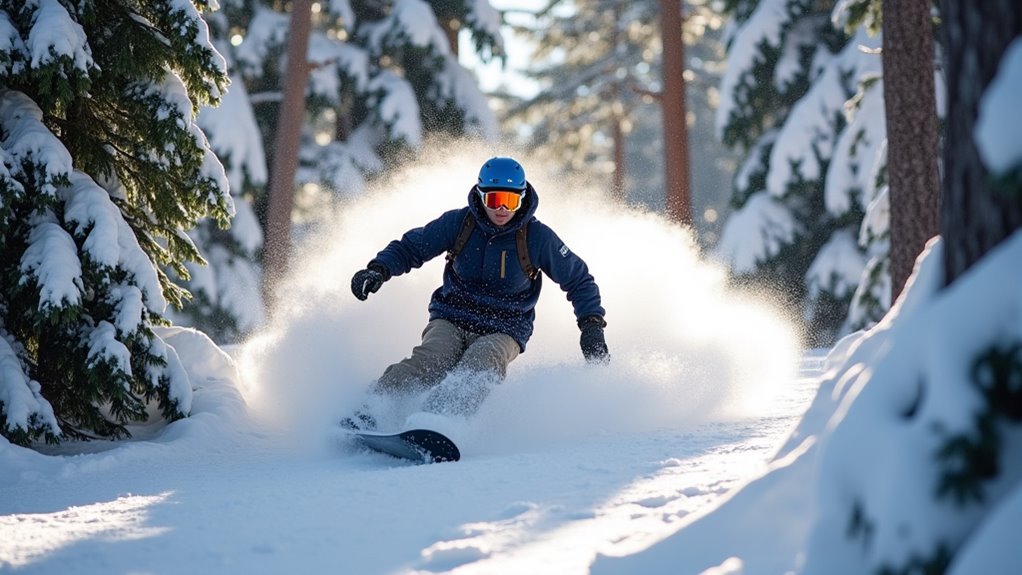
Before you even think about weaving between those towering pines, you’ll need rock-solid speed control on open terrain. Trees don’t forgive mistakes the way groomed runs do – there’s no room for panic braking or wild speed checks when you’re threading through tight spaces.
Practice your heel-side and toe-side turns until they’re second nature. Work on linking smooth, controlled S-turns down intermediate slopes. Focus on using your edges to regulate speed rather than relying on sudden stops.
You should feel comfortable maintaining a consistent, moderate pace while carving clean arcs.
Once you can confidently control your speed without thinking about it, you’re ready to tackle tree runs. Just like expecting moms need to master essential skills before camping in challenging environments, snowboarders must nail the fundamentals before venturing into tree terrain. Master this foundation first – the trees will still be there waiting.
While you’re approaching a tree run, your eyes should already be scanning ahead to identify the clearest path down the slope. Look for natural corridors between trees and avoid areas where branches hang low or trees cluster tightly together.
Plan your turns around larger trees that’ll give you stable reference points—these become your checkpoints as you descend.
Don’t fixate on individual trees; instead, focus on the gaps and open spaces. Your peripheral vision will naturally help you avoid obstacles while you’re riding toward your intended path.
Always have an exit strategy planned in case your chosen line doesn’t work out.
Remember that fresh powder can hide obstacles like rocks, stumps, or fallen branches, so be extra cautious in areas with deeper snow coverage.
Just like preparing your morning coffee with a portable espresso maker requires quick preparation, reading terrain through trees demands rapid decision-making and efficient planning.
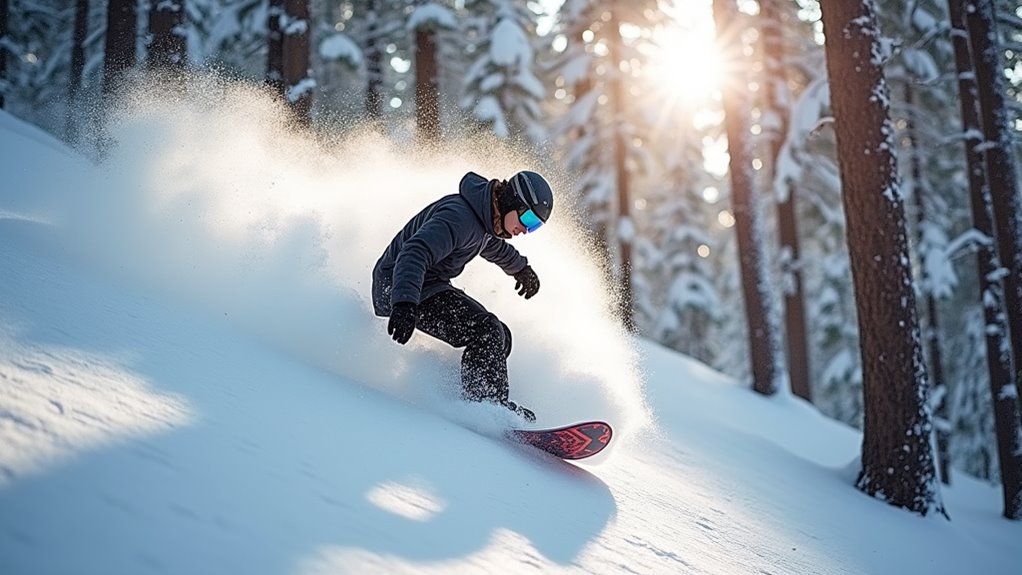
Since trees create natural slalom gates that demand precise navigation, you’ll need to master shorter, more controlled turns than you’d typically use on open slopes. Focus on quick edge-to-edge movements rather than long, carving turns. Your timing becomes critical—initiate turns earlier to account for the split-second decisions required when weaving between trunks.
Practice “bounce turns” on groomed runs first. These rapid, rhythmic turns help you maintain momentum while staying nimble. Keep your upper body quiet and let your legs do the work, absorbing terrain changes smoothly.
In tight tree sections, think “pump and redirect” rather than full turns. Sometimes a simple weight shift or board pivot is all you need. Remember, it’s better to make frequent small adjustments than commit to wide turns that might lead you into trouble.
Your stance becomes your foundation for executing those quick turns effectively among the trees. Keep your knees bent and centered over your board, maintaining a low, athletic position that’ll help you react instantly to changing terrain and obstacles.
Your weight should stay balanced between both feet, avoiding the common mistake of leaning too far forward or back when maneuvering through tight spaces.
Keep your shoulders aligned with your board’s direction and your arms relaxed but ready. Don’t lock up your upper body – tree riding demands fluid movement.
Your head should stay up, eyes scanning ahead rather than staring at the tree you’re trying to avoid.
This balanced, dynamic stance gives you maximum control and responsiveness when threading through tight corridors of trees. After a long day of navigating through the trees, you’ll appreciate having comfortable camping hammocks to ensure quality rest and recovery for your next adventure on the slopes.
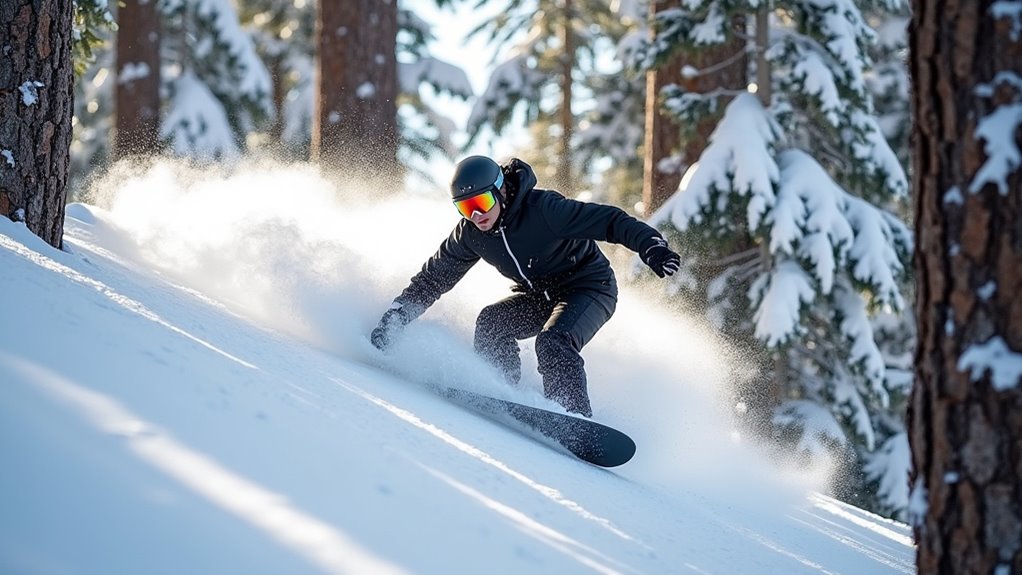
Once you’ve nailed that balanced stance, mastering lightning-fast edge shifts becomes your ticket to fluid tree runs. Quick progressions keep you dancing between obstacles instead of fighting them. Practice rapid heel-to-toe movements on open slopes first—think quick ankle flexes rather than full-body movements.
Your knees are the shock absorbers here. Keep them soft and responsive, ready to absorb terrain changes while your feet do the precision work. Focus on clean weight transfers without over-rotating your shoulders, which kills your momentum and throws off your line.
Start with mellow tree spacing and gradually work toward tighter glades. European riders call this “forest skiing”—it’s about reading the mountain’s natural rhythm.
Quick edges let you link turns seamlessly, maintaining flow while respecting the trees’ unforgiving nature. Just like dirt bike riders need essential gear for trail protection, snowboarders require proper equipment to safely navigate through challenging tree terrain.
While quick edge shifts keep you flowing through trees, emergency stops save your life when things go sideways. Master the hockey stop by throwing your board perpendicular to the fall line and digging both edges hard into the snow. Practice this until it’s muscle memory.
When a hockey stop won’t work, you’ll need bail-out techniques. The controlled fall is your friend – sit down hard on your uphill edge rather than catching a tree with your face.
If you’re moving too fast, aim for soft snow patches or small saplings that’ll slow you down without serious injury.
Always scope your escape routes before entering tight sections. Know where you can bail out safely, because even experienced tree riders need emergency exits.
Just like visitors planning their routes at Britain’s Motorhome Show, preparation and knowing your options beforehand can make all the difference in challenging situations.
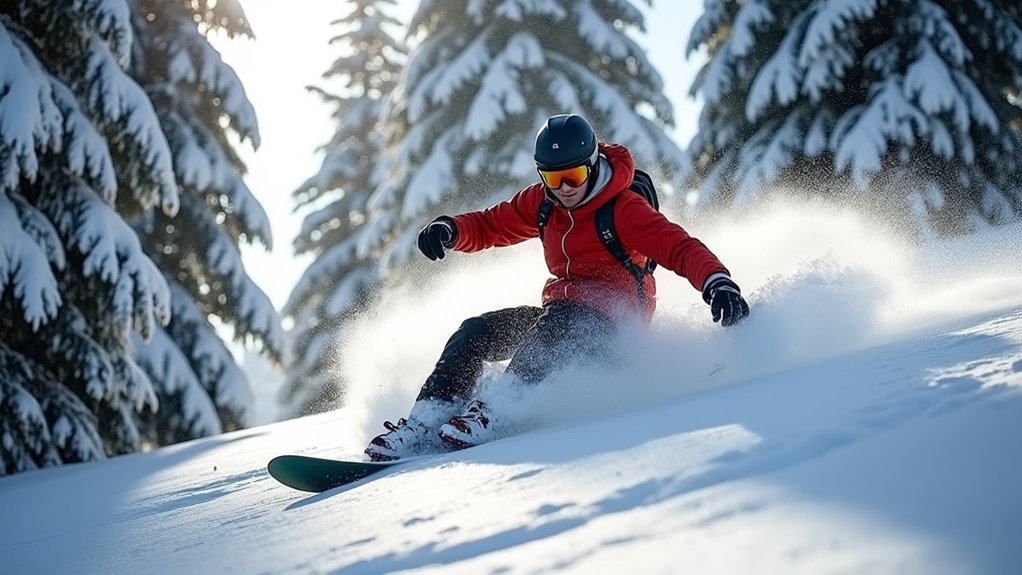
Although you can ride trees on any board, specific equipment choices make the difference between smooth lines and constant collisions. Choose a shorter, more maneuverable board that’s 3-5 centimeters smaller than your typical all-mountain setup. This reduces your turning radius and helps you navigate tight spaces more effectively.
Opt for a softer flex pattern that responds quickly to subtle movements. Stiffer boards require more aggressive input, which can throw you off balance in technical terrain. Your bindings should offer responsive heel-to-toe control without being overly aggressive.
Consider a slightly set-back stance to help with powder float and quick direction changes.
Finally, invest in quality wrist guards and back protection – trees don’t forgive mistakes like open slopes do. Just like with any major purchase, avoid common mistakes when selecting your tree riding gear by researching thoroughly and not rushing into decisions.
Before you attempt tight tree runs that’ll test your limits, build your confidence in areas where the trees are spaced far apart and mistakes won’t send you straight into bark.
Wide-spaced tree areas let you practice reading terrain while maintaining a comfortable turning radius. You’ll learn essential skills like spotting your line three turns ahead and adjusting speed without the pressure of threading narrow gaps.
Start on groomed runs with scattered trees, then progress to powder stashes between widely-spaced timber. This builds muscle memory for quick direction changes and develops your peripheral vision.
Most resorts have designated tree zones marked by difficulty—respect these ratings. Once you’re confidently linking smooth turns through open glades, you can tackle tighter spacing where precision becomes critical.
Consider bringing a portable hammock for post-ride relaxation at the base lodge or nearby trees, giving your legs a chance to recover between challenging runs.
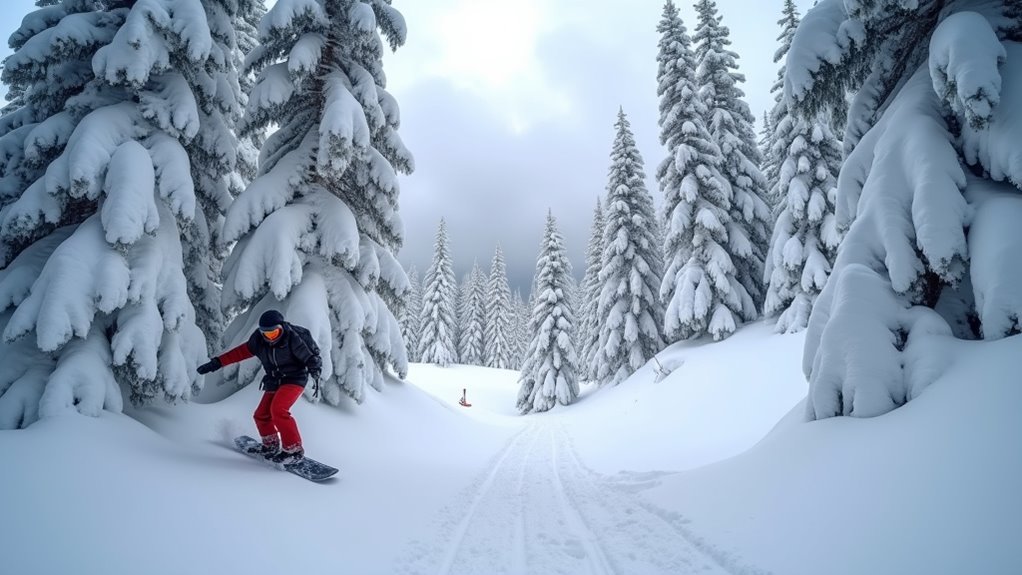
As you gain confidence maneuvering through trees, weather conditions become your biggest safety concern—particularly the hidden danger of tree wells. These invisible snow pockets form around tree bases when branches prevent snow from accumulating evenly, creating deep voids that can trap you upside-down.
Fresh powder makes tree wells especially treacherous since they’re completely concealed. You’ll want to avoid riding alone in deep snow conditions and always carry a partner who can assist if you become trapped. Stay alert after heavy snowfall—what looks like perfect powder might hide a six-foot-deep well.
Wind affects tree riding too, creating unstable snow conditions and potential avalanche danger on steeper terrain. Check weather reports before heading into the trees, and don’t let powder fever override your judgment about dangerous conditions. Just as hikers on Scotland’s West Highland Way must prepare for rapidly changing mountain weather, snowboarders need to respect the unpredictable nature of backcountry conditions.
Like maneuvering Dante’s forest, tree riding demands respect and preparation. You’ve got the roadmap now—master your speed control, read the terrain like a well-worn book, and perfect those buttery turns. Remember, even Olympic pros started with wider gaps before dancing through tight glades. Don’t rush the process; trees aren’t going anywhere, but one wrong move and you might be. Start conservative, build confidence gradually, and let the mountain teach you its ancient rhythms.